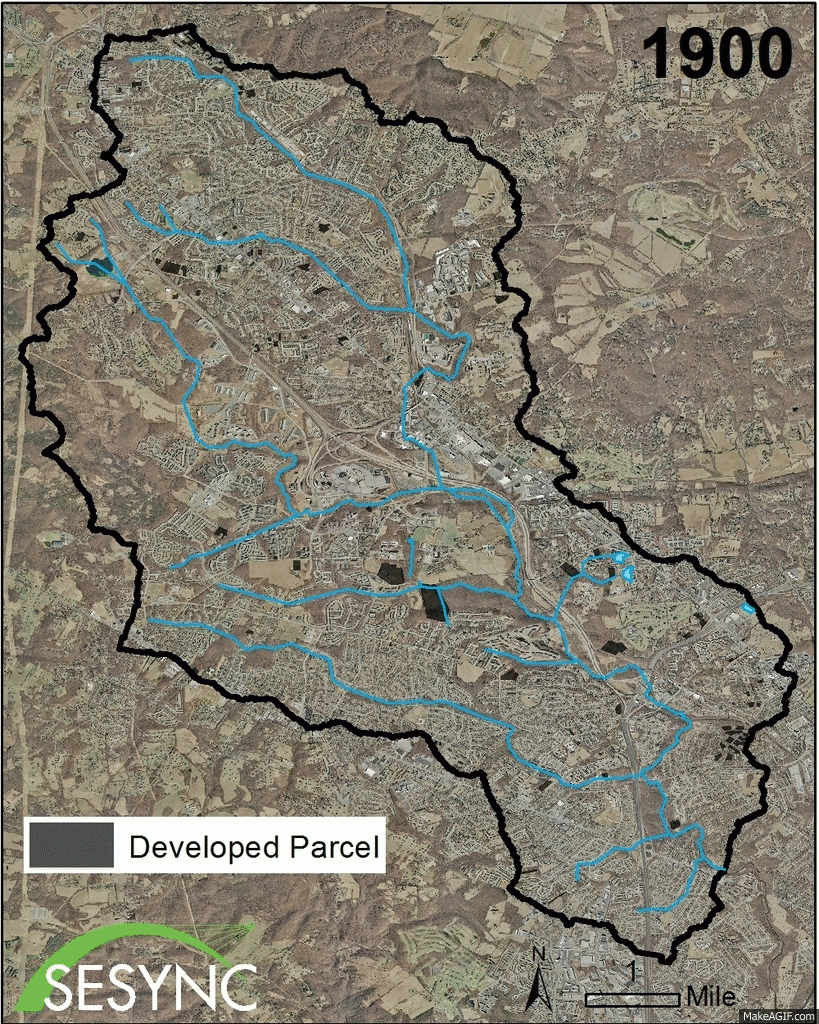
Ask any long-term resident of Baltimore, Boston, or Pittsburgh: a lot has changed over the past 60 years. Streets have spread and buildings have blossomed, covering each city with more and more of the hard, impervious surfaces that lead to surges in rain and snowmelt runoff.
Past research has shown that urbanization of a landscape significantly changes the streams that flow through developed and developing areas. But studies that look at how urbanization has impacted a stream over time are rare. After all, long-term datasets on stream flow can be hard to come by.
New research published by SESYNC postdoctoral fellow Krissy Hopkins and co-authors takes a temporal approach to understanding the urban stream syndrome in six study sites throughout Baltimore, Boston, and Pittsburgh. The researchers found that the timing and magnitude of hydrologic changes are driven by the timing and intensity of urban development. In other words, the timing of a city's peak growth sets the stage for high-flow events and floods for decades to come.
“Cities, and the streams affected by urban development, are in a constant state of change. But our research pinpoints periods of time that are critical to understanding the health of an urban stream, because the data show that the most intense period of historical growth is the primary driver of the timing of stream flow changes we observed,” Hopkins said.
The authors explain that this is most likely because the time at which peak development took place determined the dominant type of stormwater infrastructure built. For example, developments built in Maryland prior to 1985 were not required to install management practices that reduce polluted runoff. In these older developments, stormwater is piped directly to local streams without treatment. With the passing of Maryland’s first Stormwater Management law in 1982, developments constructed after 1985 are required to install practices that treat the “first flush”—i.e., the first half inch of runoff from impervious surfaces.
The researchers' results underscore the importance of understanding the dynamic development patterns of individual cities to improve predictions of future impacts on stream ecosystems. Context is king—and knowing the unique history of a city can help explain major hydrologic events such as high flows and floods.

Time lapse of development in the Gwynns Falls watershed, Maryland, courtesy Kristina Hopkins/SESYNC.
Hopkins points out that these insights are only possible with the kind of long-term data studies her team used, and she stresses the value of retrospective research to understand the drivers of change to urban streams. So what’s the next step? Hopkins says the six watersheds have different development patterns, stormwater infrastructure, and even natural landscape features that make direct cross-comparisons difficult. But a closer look at how these areas stack up against one another could help city planners develop effective water management strategies as urban areas continue to expand.
This work was supported by the Long-Term Ecological Research program’s Network Office (NSF #0832652 and #0936498) via an Urban Aquatics Working Group; the Central Arizona–Phoenix (NSF #1026865), Baltimore Ecosystem Study (NSF #1027188), and Plum Island Ecosystems (NSF #1058747) LTERs; and the University of Pittsburgh.
The research paper, “Type and timing of stream flow changes in urbanizing watersheds in the Eastern U.S.,” Kristina G. Hopkins, Nathaniel B. Morse, Daniel J. Bain, et al., was published online June 11, 2015, in the journal Elementa: Science of the Anthropocene.
The National Socio-Environmental Synthesis Center, funded through an award to the University of Maryland from the National Science Foundation, is a research center dedicated to accelerating scientific discovery at the interface of human and ecological systems. Visit us online at www.sesync.org.
Follow SESYNC on Twitter at @SESYNC and Dr. Hopkins at @kghopkin.
Top photo: An aerial view of Baltimore, Maryland, courtesy David Wilson via Flickr/Creative Commons.